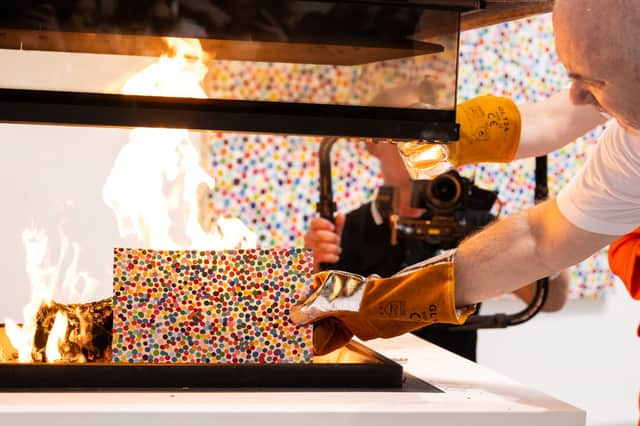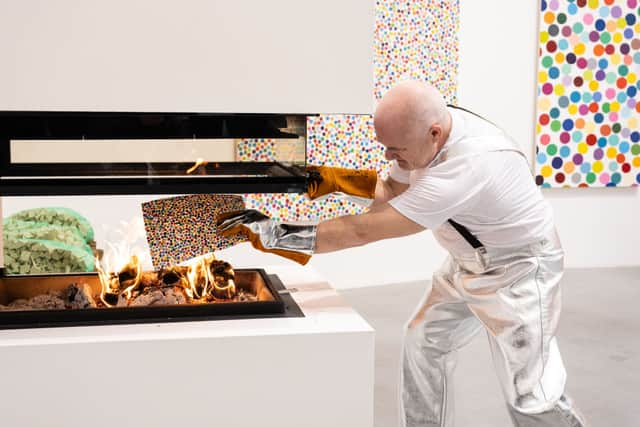Damien Hirst: why is he burning his art in gallery - The Currency NFT artworks and paintings project explained


Damien Hirst has launched the next stage of his The Currency exhibition, in which he sets fire to and destroys a collection of his trademark polka dot-style artworks.
Hirst said that he is "transforming" his art rather than burning it, as he began setting fire to thousands of his creations as part of the exhibition.
Advertisement
Hide AdAdvertisement
Hide AdBut why is he destroying a large collection of his artwork, and what does it all mean?
Here is everything you need to know about it.
Why is Damien HIrst burning his art?
The destruction of Hirst’s artwork has been the plan from the start of his The Currency project, which first began in July 2021 with 10,000 original pieces accompanied by NFTs, and the symbolic burning forms part of the art itself.
Collectors of the polka dot-style artworks were given the option of keeping either the digital or the physical version. More than half of the collectors, 5,149, decided to keep the physical artwork while 4,851 opted for the NFT.
Over the course of the exhibition held at Newport Street Gallery, all of the 4,851 physical artworks will be burned at a specified time each day until the event ends on 30 October.


Advertisement
Hide AdAdvertisement
Hide AdThe artist will be dressed in silver metallic boiler-suit trousers and matching fire safety gloves as he collects each piece and burns it in a contained fire box.
The artworks were created by hand in 2016 using enamel paint on handmade paper, with no colour duplicated twice within the same piece.
The artworks' titles were generated by a machine that had learned some of the artist's favourite song lyrics.
Each artwork is numbered, titled, stamped, and signed by the artist on the back with a watermark and hologram including a portrait of the artist etched into the paper to ensure authenticity.
Advertisement
Hide AdAdvertisement
Hide AdHirst shows each artwork to a camera before burning it to record its unique code in order to maintain a record of every piece that has been torched.
What does it all mean?
Speaking at the exhibition while burning his artwork, Hirst told the PA news agency: “I’ve never know really what the message is and I think as an artist you’re asking a question disguised as an answer.”
He added that sometimes people assumed to know what he was trying to convey but he felt the process for him was “all about finding out what happens next”.
He added that he did not see it as a waste as he felt “I’m not burning my art I’m transforming it into NFTs”.
Advertisement
Hide AdAdvertisement
Hide AdAn NFT, or non-fungible token, is a digital authentication and ownership certificate that is held on an encrypted system similar to that used for cryptocurrencies.
“I’m kind of rooted in the physical art world and I find the digital art world more challenging,” said Hirst, “but I think this has to be part of the process to create truly digital artworks is to destroy the physical artworks as the two can’t exist at the same time.”
Hirst considers The Currency exhibition to be a work of art in which individuals participate by purchasing, holding, selling, and swapping the artworks.
Comment Guidelines
National World encourages reader discussion on our stories. User feedback, insights and back-and-forth exchanges add a rich layer of context to reporting. Please review our Community Guidelines before commenting.
